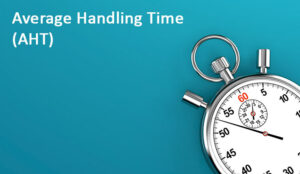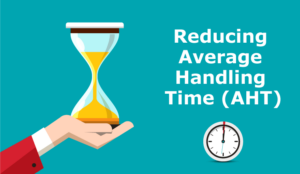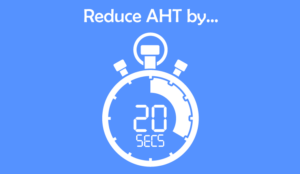Call centre productivity and success depends on excellent customer service. When customers call, it generally means there is an urgent situation that requires a quick answer. This is why it is vital to have efficient call centre practices in place that make each customer interaction both fast and productive.
Agents must provide a positive experience for the customer from start to finish, with resolution as the end goal. One way to do this is by understanding one of the key metrics in a call centre quality assurance plan, the call centre’s secret weapon to success: understanding, and lowering, your Average Handling Time (AHT).
This handy metric has a dual purpose: to raise customer service standards and monitor agent performance. It is important to remember that the AHT is one of several key KPIs for call centre success. Other metrics include:
- Customer Satisfaction Scores
- Net Promoter Scores
- First call resolution rate
- Annual turnover rate
Why Is Average Handling Time Important?
First of all, what is average handling time? The AHT is the total amount of time an agent spends resolving a customer call. This metric measures time across various platforms, like text bot and email, and includes holds, delays, and transfers. Average Handling Time is important because:
- 66% of customers prefer to resolve issues over the phone.
- 32% of customers will leave a company after a single bad experience.
- 60% of unhappy customers will share their thoughts on social media platforms.
These statistics show how vital it is to improve customer experience. Understanding and lowering AHT helps call centres refine processes, training procedures, and improve satisfaction scores over time.
AHT can and does vary by industry. In a contact centre, AHT is important to track for measuring agent efficiency and understanding customer satisfaction.
- Average handling times per channel. When examining AHT, make sure to account for handling times on all communication channels, not just the phone. These channels include text bots, emails, messenger apps.
- Average handling time in contact centres. Understanding AHT has a two-fold benefit for contact centres. It measures agent effectiveness and training level, plus it provides an overview of the call centre’s overall productivity.
The AHT is not the ‘be all and end all’ of QA metrics. But it is important because it is part of the overall picture of improving the customer journey.
How Do You Calculate Average Handling Time?
The industry-standard AHT is 6 minutes and 10 seconds. This is a good baseline to shoot for when calculating your own AHT. Once you have some data available, it is easy to calculate your average handling time.
Your AHT is your total talk time plus your total hold time and your total after-call tasks. When you’ve added these together, divide that total by the number of calls.
(Talk + Hold + Delay + Follow-Up) / #Calls = Average Handle Time (calculated in minutes or seconds)
Make sure to adjust this formula for each channel you are monitoring. For example, an email will not have a hold time, but a text chat may have holds and delays. Be cognizant of your channels so that you are measuring AHT correctly each time.
How Can You Improve Average Handling Time?
The AHT can be your secret weapon in quality assurance. But it needs to be understood and used appropriately. It is important to remember that lower AHT times alone does not mean an automatic improvement in customer service. Rather, AHT is best viewed as part of a whole suite of performance metrics that require equal focus and attention.
But AHT is a great metric to start with as you explore quality assurance further. Here are a few ways you can improve your average handling time:
1. Identify the Root Cause of Lengthy AHT Numbers
This is only achievable through 100% call monitoring. Quality assurance tools like scorecards and reporting and analytical tools can easily and efficiently track hold times, customer moods, and other impacts on AHT across all channels.
Identifying the root cause can identify patterns, issues, and problem areas that might be causing longer AHT.
2. Put Agent Coaching Sessions Front and Centre
Proper training is imperative for reducing AHT. Untrained agents risk fumbling through calls, which can increase both hold times and customer dissatisfaction. A focus on data-driven, long-term improvements, with an emphasis on empathy, will help agents get better and faster on calls.
3. Review Average Handling Time Over Time
Month-on-month reviews will give an idea of the efficiency of your contact centre. Prioritize comparing your AHT numbers monthly to get an idea of trends.
4. Get Your Knowledge Base in Order
Sometimes AHT is about more than agent performance, but about the resources they have available to them. Agents need a knowledge base that they can refer to quickly and easily. Create a resource library with helpful articles, blogs, and tutorials that can help them grasp the importance of reducing AHT.
5. Embrace Automation
AI automation can assist with time-consuming tasks like chat-bot interactions or email processes. AI can also help monitor trends, issues, and any complications with agent or product processes.
Average handling time is a great metric to get your head around. While many might call it a lazy metric, AHT is anything but lazy. It can point to efficiencies (or inefficiencies) and works best as part of the big picture of data analysis. It helps call centres understand what they are doing right and where they need improvements in their processes.
The Bottom Line: AHT Is a Crucial Part of a Quality Assurance Plan
Reducing average handling time is an important way to measure a call centre’s efficiency. But it isn’t the only QA metric that matters. Rather, AHT is one part of a larger plan to raise customer service standards. It is important to understand how all these tools work together to get call centres to their goals.
This blog post has been re-published by kind permission of Scorebuddy – View the Original Article
For more information about Scorebuddy - visit the Scorebuddy Website
Call Centre Helper is not responsible for the content of these guest blog posts. The opinions expressed in this article are those of the author, and do not necessarily reflect those of Call Centre Helper.
Author: Scorebuddy
Published On: 18th Mar 2022 - Last modified: 27th Apr 2022
Read more about - Guest Blogs, Scorebuddy






 Scorebuddy is quality assurance solution for scoring customer service calls, emails and web chat. It is a dedicated, stand-alone staff scoring system based in the cloud, requiring no integration.
Scorebuddy is quality assurance solution for scoring customer service calls, emails and web chat. It is a dedicated, stand-alone staff scoring system based in the cloud, requiring no integration. 









